Managing Food and Beverage Operations: Types of Businesses, Rating Systems, and Current and Future Trends
VerifiedAdded on 2023/06/18
|12
|3980
|374
AI Summary
This report discusses the different types of businesses in the food and beverage industry, including fine dining restaurants, bars and pubs, traditional restaurants, cafes, catering businesses, counter service, self-service, and bakeries. It also covers rating systems used, such as Michelin stars, star ratings, and AA Rosettes, as well as current and future trends affecting the industry, including social distancing and disinfecting rules, contactless service and updated payment systems, sustainability, tech-led recovery, minimum use of reusable accessories, and artificial intelligence. Finally, the report explores strategies used to attract and develop customer loyalty, such as identifying customer needs and wants.
Contribute Materials
Your contribution can guide someone’s learning journey. Share your
documents today.
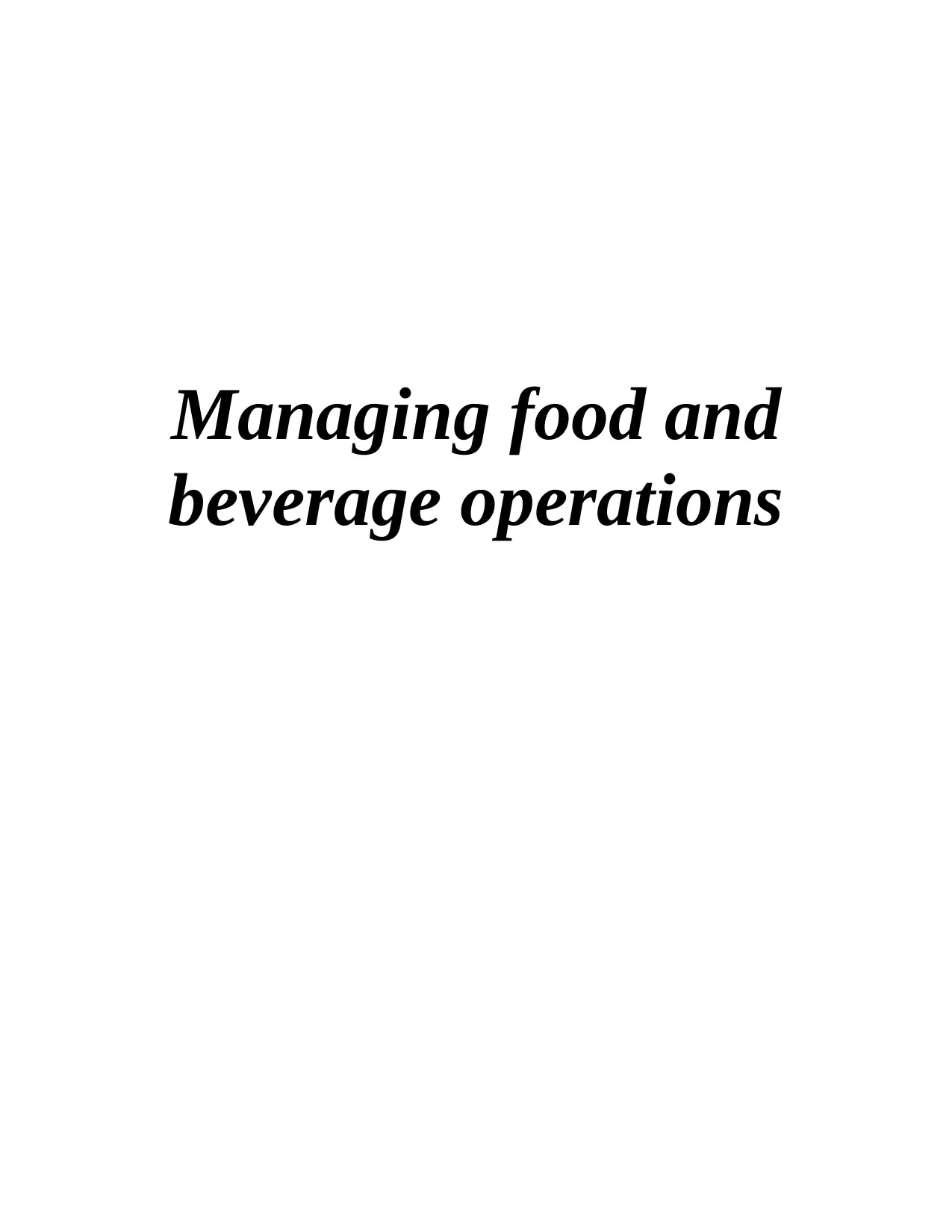
Managing food and
beverage operations
beverage operations
Secure Best Marks with AI Grader
Need help grading? Try our AI Grader for instant feedback on your assignments.
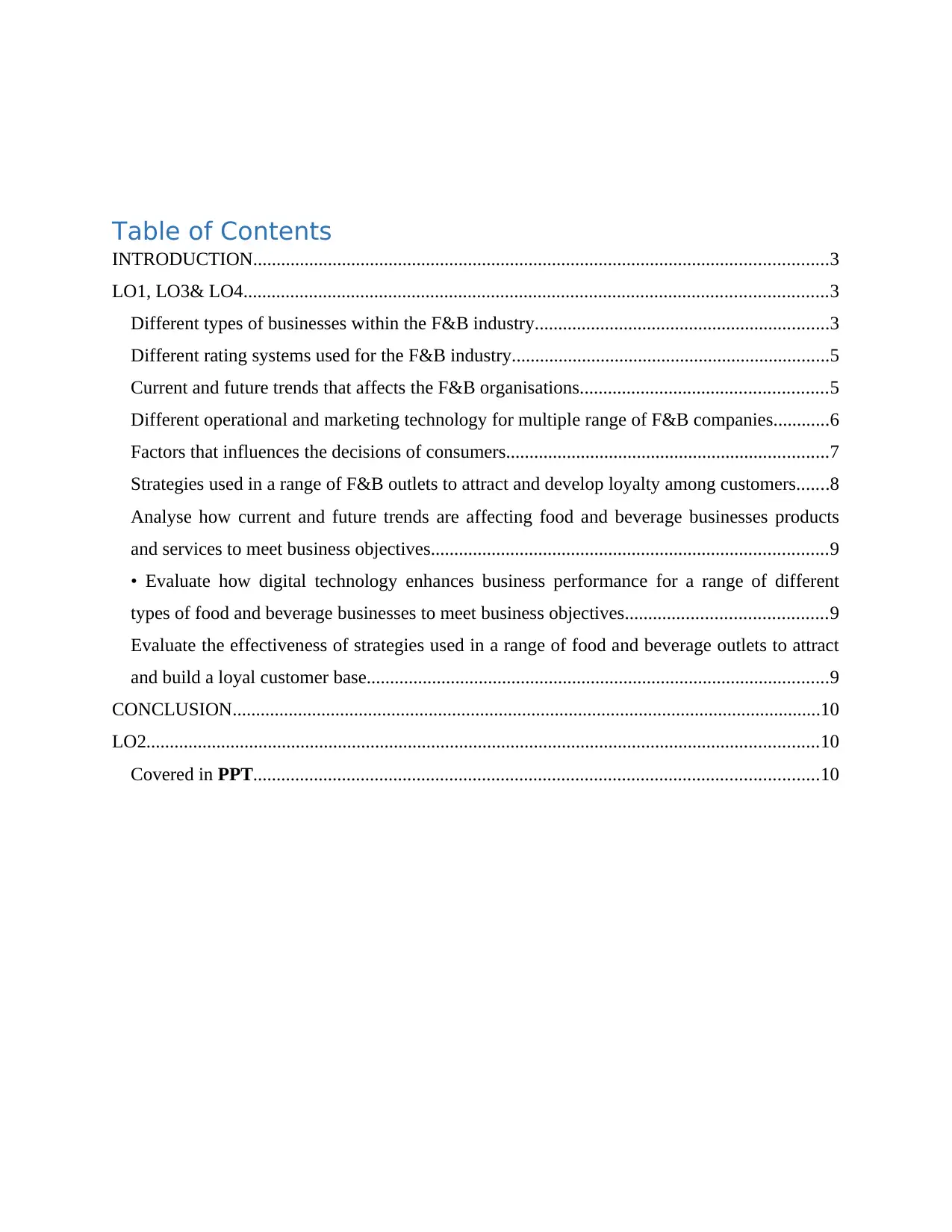
Table of Contents
INTRODUCTION...........................................................................................................................3
LO1, LO3& LO4.............................................................................................................................3
Different types of businesses within the F&B industry...............................................................3
Different rating systems used for the F&B industry....................................................................5
Current and future trends that affects the F&B organisations.....................................................5
Different operational and marketing technology for multiple range of F&B companies............6
Factors that influences the decisions of consumers.....................................................................7
Strategies used in a range of F&B outlets to attract and develop loyalty among customers.......8
Analyse how current and future trends are affecting food and beverage businesses products
and services to meet business objectives.....................................................................................9
• Evaluate how digital technology enhances business performance for a range of different
types of food and beverage businesses to meet business objectives...........................................9
Evaluate the effectiveness of strategies used in a range of food and beverage outlets to attract
and build a loyal customer base...................................................................................................9
CONCLUSION..............................................................................................................................10
LO2................................................................................................................................................10
Covered in PPT.........................................................................................................................10
INTRODUCTION...........................................................................................................................3
LO1, LO3& LO4.............................................................................................................................3
Different types of businesses within the F&B industry...............................................................3
Different rating systems used for the F&B industry....................................................................5
Current and future trends that affects the F&B organisations.....................................................5
Different operational and marketing technology for multiple range of F&B companies............6
Factors that influences the decisions of consumers.....................................................................7
Strategies used in a range of F&B outlets to attract and develop loyalty among customers.......8
Analyse how current and future trends are affecting food and beverage businesses products
and services to meet business objectives.....................................................................................9
• Evaluate how digital technology enhances business performance for a range of different
types of food and beverage businesses to meet business objectives...........................................9
Evaluate the effectiveness of strategies used in a range of food and beverage outlets to attract
and build a loyal customer base...................................................................................................9
CONCLUSION..............................................................................................................................10
LO2................................................................................................................................................10
Covered in PPT.........................................................................................................................10

INTRODUCTION
The food and beverage industry is very broad and vast in nature. It involves restaurants,
cafes, fast food joints, cafeterias, pubs, catering businesses, food manufacturing operations, food
transportation services and many more. Nowadays, the food and beverage industry would well
adopt global standards of safety and quality in order to gain trust among customer. In the
hospitality sector, food and beverages sector caters a range of opportunities to grow and develop
a successful business. Companies within such sectors can consist everything from a star
restaurant and a range of catering services to bars and food and beverage service caterer for
resorts and hotels. The company which is taken in this report is Greggs Plc which is a famous
bakery chain in British administration. The headquarter of the company is in Newcastle upon
Tyne, United Kingdom (Ab Talib, 2017). The bakery is popular for its savoury products such as
sausage rolls, bakes, sandwiches and other sweet products which including vanilla slices and
doughnuts. In 1939, the company was established by John Gregg. The following report is based
on the different topics related with food and beverage operations such as different types of
businesses in F&B sectors, different rating systems and recent industry trends. Along with this,
this report also covers legal aspects and regulatory standards that food and beverage businesses
required. It focuses on the factors that influence customers decision-making and tactics that can
be used to attract and build customer loyalty towards the brand.
LO1, LO3& LO4
Different types of businesses within the F&B industry.
Food and beverage services can be understood as an establishment or places where
companies mainly engaged in the sales of prepared food and beverages. In other terms, it refers
to a process consist with preparation, presentation and serving foods and beverages to the
consumers. In context of Greggs, there are different types of businesses which provides catering
services. Some of them are discussed underneath:
Fine dining restaurants: This can be simply understood as a luxury restaurant which services
special means with special kind of presentations to their high profile customers. Such type of
businesses has highly advanced menus and prices. It is also known as white tablecloth restaurant,
which looks luxurious and fancier while delighting their upscale customers. Generally, these type
The food and beverage industry is very broad and vast in nature. It involves restaurants,
cafes, fast food joints, cafeterias, pubs, catering businesses, food manufacturing operations, food
transportation services and many more. Nowadays, the food and beverage industry would well
adopt global standards of safety and quality in order to gain trust among customer. In the
hospitality sector, food and beverages sector caters a range of opportunities to grow and develop
a successful business. Companies within such sectors can consist everything from a star
restaurant and a range of catering services to bars and food and beverage service caterer for
resorts and hotels. The company which is taken in this report is Greggs Plc which is a famous
bakery chain in British administration. The headquarter of the company is in Newcastle upon
Tyne, United Kingdom (Ab Talib, 2017). The bakery is popular for its savoury products such as
sausage rolls, bakes, sandwiches and other sweet products which including vanilla slices and
doughnuts. In 1939, the company was established by John Gregg. The following report is based
on the different topics related with food and beverage operations such as different types of
businesses in F&B sectors, different rating systems and recent industry trends. Along with this,
this report also covers legal aspects and regulatory standards that food and beverage businesses
required. It focuses on the factors that influence customers decision-making and tactics that can
be used to attract and build customer loyalty towards the brand.
LO1, LO3& LO4
Different types of businesses within the F&B industry.
Food and beverage services can be understood as an establishment or places where
companies mainly engaged in the sales of prepared food and beverages. In other terms, it refers
to a process consist with preparation, presentation and serving foods and beverages to the
consumers. In context of Greggs, there are different types of businesses which provides catering
services. Some of them are discussed underneath:
Fine dining restaurants: This can be simply understood as a luxury restaurant which services
special means with special kind of presentations to their high profile customers. Such type of
businesses has highly advanced menus and prices. It is also known as white tablecloth restaurant,
which looks luxurious and fancier while delighting their upscale customers. Generally, these type
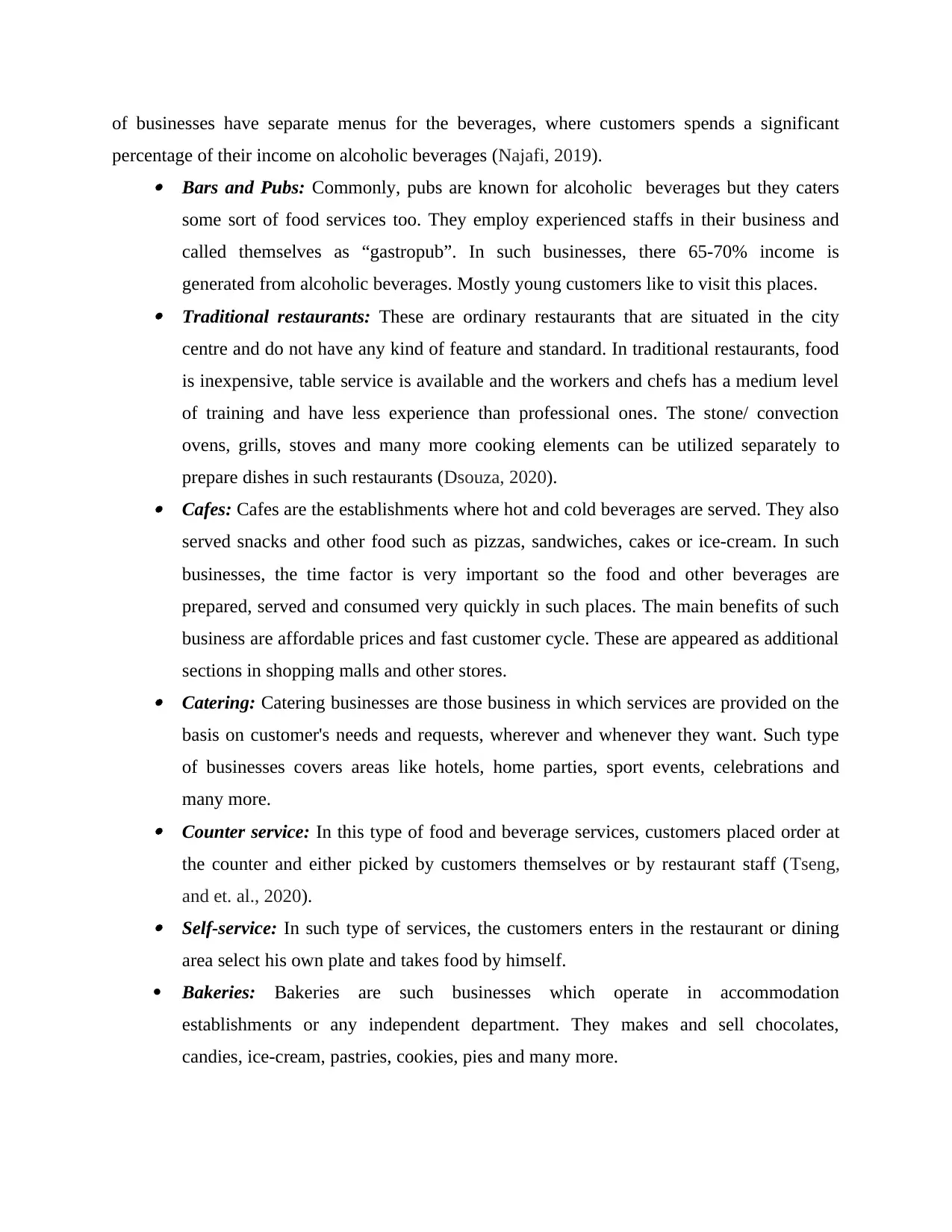
of businesses have separate menus for the beverages, where customers spends a significant
percentage of their income on alcoholic beverages (Najafi, 2019). Bars and Pubs: Commonly, pubs are known for alcoholic beverages but they caters
some sort of food services too. They employ experienced staffs in their business and
called themselves as “gastropub”. In such businesses, there 65-70% income is
generated from alcoholic beverages. Mostly young customers like to visit this places. Traditional restaurants: These are ordinary restaurants that are situated in the city
centre and do not have any kind of feature and standard. In traditional restaurants, food
is inexpensive, table service is available and the workers and chefs has a medium level
of training and have less experience than professional ones. The stone/ convection
ovens, grills, stoves and many more cooking elements can be utilized separately to
prepare dishes in such restaurants (Dsouza, 2020). Cafes: Cafes are the establishments where hot and cold beverages are served. They also
served snacks and other food such as pizzas, sandwiches, cakes or ice-cream. In such
businesses, the time factor is very important so the food and other beverages are
prepared, served and consumed very quickly in such places. The main benefits of such
business are affordable prices and fast customer cycle. These are appeared as additional
sections in shopping malls and other stores. Catering: Catering businesses are those business in which services are provided on the
basis on customer's needs and requests, wherever and whenever they want. Such type
of businesses covers areas like hotels, home parties, sport events, celebrations and
many more. Counter service: In this type of food and beverage services, customers placed order at
the counter and either picked by customers themselves or by restaurant staff (Tseng,
and et. al., 2020). Self-service: In such type of services, the customers enters in the restaurant or dining
area select his own plate and takes food by himself.
Bakeries: Bakeries are such businesses which operate in accommodation
establishments or any independent department. They makes and sell chocolates,
candies, ice-cream, pastries, cookies, pies and many more.
percentage of their income on alcoholic beverages (Najafi, 2019). Bars and Pubs: Commonly, pubs are known for alcoholic beverages but they caters
some sort of food services too. They employ experienced staffs in their business and
called themselves as “gastropub”. In such businesses, there 65-70% income is
generated from alcoholic beverages. Mostly young customers like to visit this places. Traditional restaurants: These are ordinary restaurants that are situated in the city
centre and do not have any kind of feature and standard. In traditional restaurants, food
is inexpensive, table service is available and the workers and chefs has a medium level
of training and have less experience than professional ones. The stone/ convection
ovens, grills, stoves and many more cooking elements can be utilized separately to
prepare dishes in such restaurants (Dsouza, 2020). Cafes: Cafes are the establishments where hot and cold beverages are served. They also
served snacks and other food such as pizzas, sandwiches, cakes or ice-cream. In such
businesses, the time factor is very important so the food and other beverages are
prepared, served and consumed very quickly in such places. The main benefits of such
business are affordable prices and fast customer cycle. These are appeared as additional
sections in shopping malls and other stores. Catering: Catering businesses are those business in which services are provided on the
basis on customer's needs and requests, wherever and whenever they want. Such type
of businesses covers areas like hotels, home parties, sport events, celebrations and
many more. Counter service: In this type of food and beverage services, customers placed order at
the counter and either picked by customers themselves or by restaurant staff (Tseng,
and et. al., 2020). Self-service: In such type of services, the customers enters in the restaurant or dining
area select his own plate and takes food by himself.
Bakeries: Bakeries are such businesses which operate in accommodation
establishments or any independent department. They makes and sell chocolates,
candies, ice-cream, pastries, cookies, pies and many more.
Secure Best Marks with AI Grader
Need help grading? Try our AI Grader for instant feedback on your assignments.

Different rating systems used for the F&B industry.
Rating systems in the food and beverage industry helps to identify the restaurant's quality
using notations such as symbols or stars or numbers. Stars are the most common and familiar
symbol which is commonly used by service providers. In context of Greggs, the following are
the types of rating systems that can be used by an organisation: Michelin star: Michelin series is one of the oldest and popular guide which award one to
three stars to establishments for serving their services to the customers. One star denotes
a “very good restaurant”, two stars denotes a place “worth a detour” and three starts
represents “exceptional cuisine'. The acquisition or loss of a Michelin star can have a
huge effects on the success of the restaurant business (Loustaunau, 2018). Star ratings: This method is used by all types of businesses in the hotel industry
throughout the world. Star rating is one the effective method of grading establishments to
help guests make a best choice for having a positive experience that matches with their
budget and needs (Chitauro, and Khumalo, 2020).
AA Rosettes: This method means awarded exclusively AA hotel and restaurant
inspectors. These refers to such establishments that attains high quality standards that
demand national identification beyond their locality. In other terms, they are award rather
than a rating system. It is done on annual basis on a rising scale on 1-5.
Current and future trends that affects the F&B organisations.
A trend means a common way in which something is changing or developing such as
lifestyle, fashion and many more. In context of Greggs, there are various trends that affect the
food and beverage industry:
Social distancing and disinfecting rules for customers: Many restaurant, cafes or bars
install barriers and “no-seat seats” in their premises to maintain the adequate distance between
guests entering the establishments. Also, the service provider limit the capacity while ensuring
that controllable number of visitors dine at once. This will also ensure the fulfilment of safety
and hygiene norms (Prayitno, Apriliana, and Edison, 2020). Contactless service and updated payment system: Post pandemic affects a lot in the
business processes. One of the effect is online or contactless payment which becomes
mandatory. Restaurant businesses must consider that their customers do minimal physical
Rating systems in the food and beverage industry helps to identify the restaurant's quality
using notations such as symbols or stars or numbers. Stars are the most common and familiar
symbol which is commonly used by service providers. In context of Greggs, the following are
the types of rating systems that can be used by an organisation: Michelin star: Michelin series is one of the oldest and popular guide which award one to
three stars to establishments for serving their services to the customers. One star denotes
a “very good restaurant”, two stars denotes a place “worth a detour” and three starts
represents “exceptional cuisine'. The acquisition or loss of a Michelin star can have a
huge effects on the success of the restaurant business (Loustaunau, 2018). Star ratings: This method is used by all types of businesses in the hotel industry
throughout the world. Star rating is one the effective method of grading establishments to
help guests make a best choice for having a positive experience that matches with their
budget and needs (Chitauro, and Khumalo, 2020).
AA Rosettes: This method means awarded exclusively AA hotel and restaurant
inspectors. These refers to such establishments that attains high quality standards that
demand national identification beyond their locality. In other terms, they are award rather
than a rating system. It is done on annual basis on a rising scale on 1-5.
Current and future trends that affects the F&B organisations.
A trend means a common way in which something is changing or developing such as
lifestyle, fashion and many more. In context of Greggs, there are various trends that affect the
food and beverage industry:
Social distancing and disinfecting rules for customers: Many restaurant, cafes or bars
install barriers and “no-seat seats” in their premises to maintain the adequate distance between
guests entering the establishments. Also, the service provider limit the capacity while ensuring
that controllable number of visitors dine at once. This will also ensure the fulfilment of safety
and hygiene norms (Prayitno, Apriliana, and Edison, 2020). Contactless service and updated payment system: Post pandemic affects a lot in the
business processes. One of the effect is online or contactless payment which becomes
mandatory. Restaurant businesses must consider that their customers do minimal physical
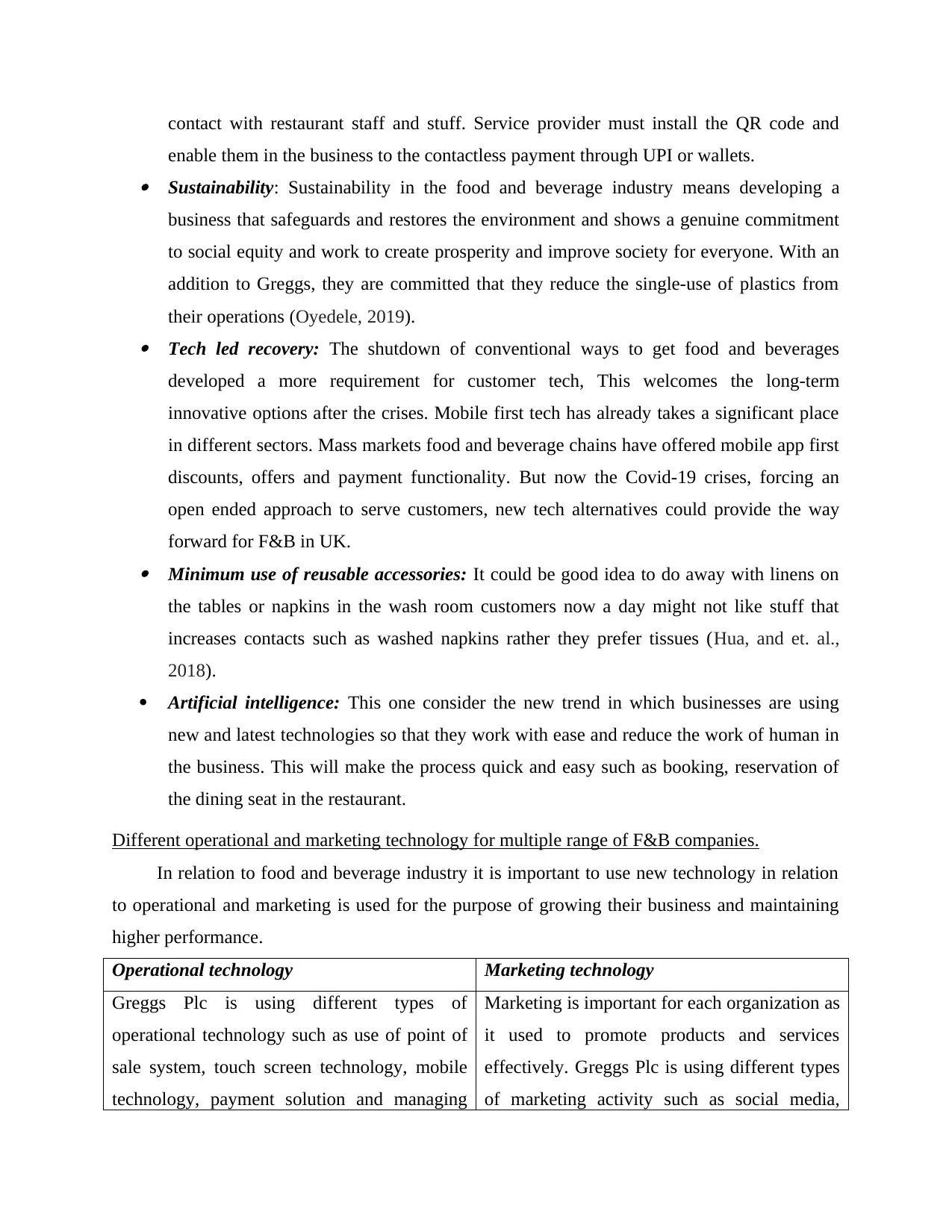
contact with restaurant staff and stuff. Service provider must install the QR code and
enable them in the business to the contactless payment through UPI or wallets. Sustainability: Sustainability in the food and beverage industry means developing a
business that safeguards and restores the environment and shows a genuine commitment
to social equity and work to create prosperity and improve society for everyone. With an
addition to Greggs, they are committed that they reduce the single-use of plastics from
their operations (Oyedele, 2019). Tech led recovery: The shutdown of conventional ways to get food and beverages
developed a more requirement for customer tech, This welcomes the long-term
innovative options after the crises. Mobile first tech has already takes a significant place
in different sectors. Mass markets food and beverage chains have offered mobile app first
discounts, offers and payment functionality. But now the Covid-19 crises, forcing an
open ended approach to serve customers, new tech alternatives could provide the way
forward for F&B in UK. Minimum use of reusable accessories: It could be good idea to do away with linens on
the tables or napkins in the wash room customers now a day might not like stuff that
increases contacts such as washed napkins rather they prefer tissues (Hua, and et. al.,
2018).
Artificial intelligence: This one consider the new trend in which businesses are using
new and latest technologies so that they work with ease and reduce the work of human in
the business. This will make the process quick and easy such as booking, reservation of
the dining seat in the restaurant.
Different operational and marketing technology for multiple range of F&B companies.
In relation to food and beverage industry it is important to use new technology in relation
to operational and marketing is used for the purpose of growing their business and maintaining
higher performance.
Operational technology Marketing technology
Greggs Plc is using different types of
operational technology such as use of point of
sale system, touch screen technology, mobile
technology, payment solution and managing
Marketing is important for each organization as
it used to promote products and services
effectively. Greggs Plc is using different types
of marketing activity such as social media,
enable them in the business to the contactless payment through UPI or wallets. Sustainability: Sustainability in the food and beverage industry means developing a
business that safeguards and restores the environment and shows a genuine commitment
to social equity and work to create prosperity and improve society for everyone. With an
addition to Greggs, they are committed that they reduce the single-use of plastics from
their operations (Oyedele, 2019). Tech led recovery: The shutdown of conventional ways to get food and beverages
developed a more requirement for customer tech, This welcomes the long-term
innovative options after the crises. Mobile first tech has already takes a significant place
in different sectors. Mass markets food and beverage chains have offered mobile app first
discounts, offers and payment functionality. But now the Covid-19 crises, forcing an
open ended approach to serve customers, new tech alternatives could provide the way
forward for F&B in UK. Minimum use of reusable accessories: It could be good idea to do away with linens on
the tables or napkins in the wash room customers now a day might not like stuff that
increases contacts such as washed napkins rather they prefer tissues (Hua, and et. al.,
2018).
Artificial intelligence: This one consider the new trend in which businesses are using
new and latest technologies so that they work with ease and reduce the work of human in
the business. This will make the process quick and easy such as booking, reservation of
the dining seat in the restaurant.
Different operational and marketing technology for multiple range of F&B companies.
In relation to food and beverage industry it is important to use new technology in relation
to operational and marketing is used for the purpose of growing their business and maintaining
higher performance.
Operational technology Marketing technology
Greggs Plc is using different types of
operational technology such as use of point of
sale system, touch screen technology, mobile
technology, payment solution and managing
Marketing is important for each organization as
it used to promote products and services
effectively. Greggs Plc is using different types
of marketing activity such as social media,

food delivery system that can help to influence
number of customers and make buying
decisions. The point of sale system is used by
customer to make payment of purchased
products and services via card. The payment
technology considered cash and cards that can
help to make contactless payment in changing
environment. Touch screen technology is used
to provide E-menu that can help to strengthen
brand identity (Supriadi, 2019).
multimedia platform and customer feedback
that used to support customer database
management. Thus is important for each
organization to understand what is running in
environment and how to influence number of
customers. Thus, this technology helps to bring
changes in their task and accomplish business
goals effectively.
Factors that influences the decisions of consumers.
It is very crucial for the Greggs Plc to acknowledge the different factors that influence the
customers decision in order to select for the services. In context of Greggs, if they are able to
understand these factors then it can easily get their aims for business. The main reason behind
this is to serve the customers as per their requirements and attracts them to enjoy services with
Greggs. The following are some factors that influences customer's decision-making: Food quality: It is very obvious that customers opt for those services which delivers
quality in their products. The quality of food is the most vital factor that can influence the
decision of customers in order to select the bakery. For instance, if a customer wants to
take a product from the bakery but at the time of choosing the company , it is important
for them to choose the quality services (Dornier, and Mauri, 2018). Staff behaviour: Restaurant or bakery staff acts as the face of the company. Many bakers
believe in hiring the staff through strict process while others believe in strict training. The
staff must include the norms that are aligned with the experience of customer and
company assures that promise must be fulfilled. Ambience: It is one of the another factor that impacts the decision of consumer. It is
studied that interior and ambience of company plays an important role to attract the
customers. When customers having positive vibe and attracting views of the premises
number of customers and make buying
decisions. The point of sale system is used by
customer to make payment of purchased
products and services via card. The payment
technology considered cash and cards that can
help to make contactless payment in changing
environment. Touch screen technology is used
to provide E-menu that can help to strengthen
brand identity (Supriadi, 2019).
multimedia platform and customer feedback
that used to support customer database
management. Thus is important for each
organization to understand what is running in
environment and how to influence number of
customers. Thus, this technology helps to bring
changes in their task and accomplish business
goals effectively.
Factors that influences the decisions of consumers.
It is very crucial for the Greggs Plc to acknowledge the different factors that influence the
customers decision in order to select for the services. In context of Greggs, if they are able to
understand these factors then it can easily get their aims for business. The main reason behind
this is to serve the customers as per their requirements and attracts them to enjoy services with
Greggs. The following are some factors that influences customer's decision-making: Food quality: It is very obvious that customers opt for those services which delivers
quality in their products. The quality of food is the most vital factor that can influence the
decision of customers in order to select the bakery. For instance, if a customer wants to
take a product from the bakery but at the time of choosing the company , it is important
for them to choose the quality services (Dornier, and Mauri, 2018). Staff behaviour: Restaurant or bakery staff acts as the face of the company. Many bakers
believe in hiring the staff through strict process while others believe in strict training. The
staff must include the norms that are aligned with the experience of customer and
company assures that promise must be fulfilled. Ambience: It is one of the another factor that impacts the decision of consumer. It is
studied that interior and ambience of company plays an important role to attract the
customers. When customers having positive vibe and attracting views of the premises
Paraphrase This Document
Need a fresh take? Get an instant paraphrase of this document with our AI Paraphraser
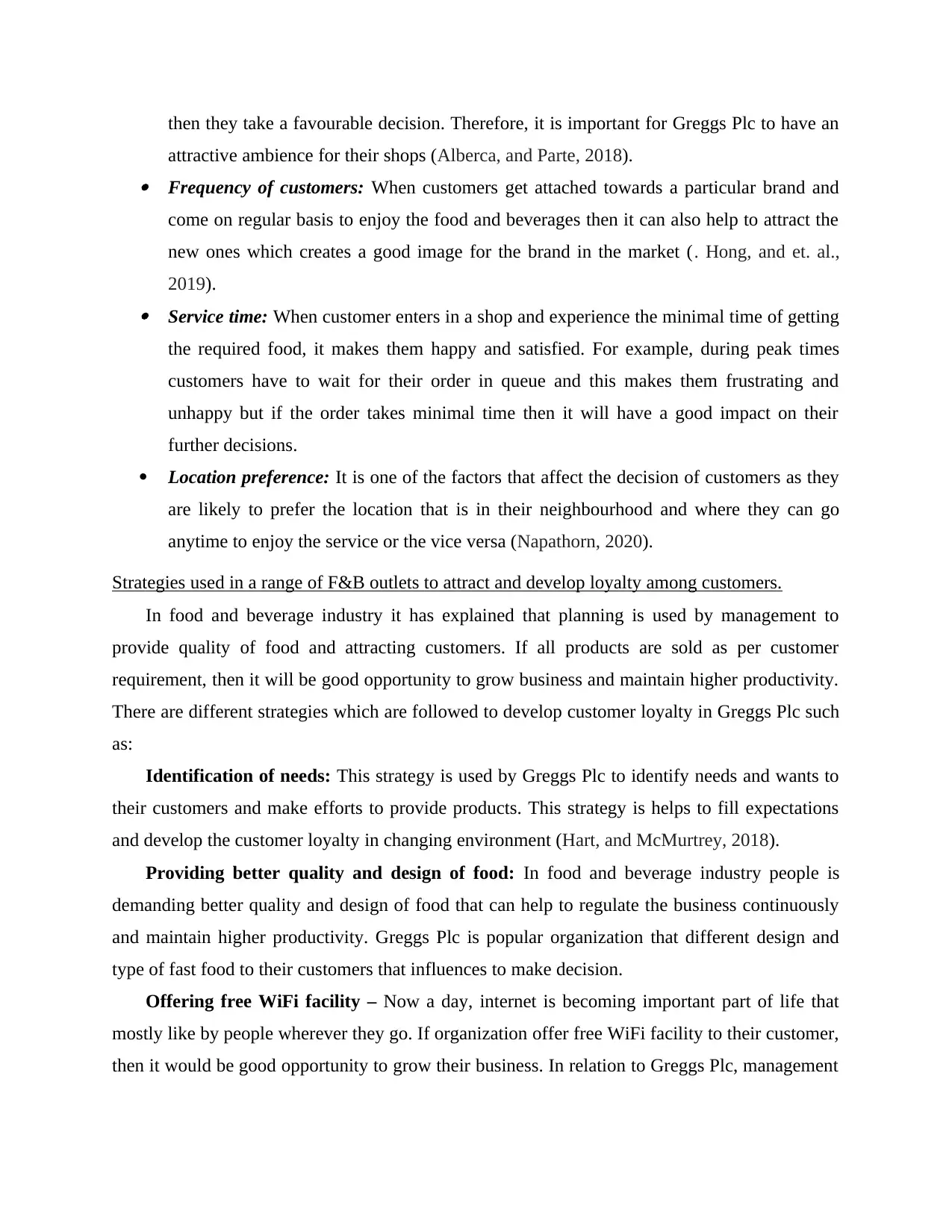
then they take a favourable decision. Therefore, it is important for Greggs Plc to have an
attractive ambience for their shops (Alberca, and Parte, 2018). Frequency of customers: When customers get attached towards a particular brand and
come on regular basis to enjoy the food and beverages then it can also help to attract the
new ones which creates a good image for the brand in the market (. Hong, and et. al.,
2019). Service time: When customer enters in a shop and experience the minimal time of getting
the required food, it makes them happy and satisfied. For example, during peak times
customers have to wait for their order in queue and this makes them frustrating and
unhappy but if the order takes minimal time then it will have a good impact on their
further decisions.
Location preference: It is one of the factors that affect the decision of customers as they
are likely to prefer the location that is in their neighbourhood and where they can go
anytime to enjoy the service or the vice versa (Napathorn, 2020).
Strategies used in a range of F&B outlets to attract and develop loyalty among customers.
In food and beverage industry it has explained that planning is used by management to
provide quality of food and attracting customers. If all products are sold as per customer
requirement, then it will be good opportunity to grow business and maintain higher productivity.
There are different strategies which are followed to develop customer loyalty in Greggs Plc such
as:
Identification of needs: This strategy is used by Greggs Plc to identify needs and wants to
their customers and make efforts to provide products. This strategy is helps to fill expectations
and develop the customer loyalty in changing environment (Hart, and McMurtrey, 2018).
Providing better quality and design of food: In food and beverage industry people is
demanding better quality and design of food that can help to regulate the business continuously
and maintain higher productivity. Greggs Plc is popular organization that different design and
type of fast food to their customers that influences to make decision.
Offering free WiFi facility – Now a day, internet is becoming important part of life that
mostly like by people wherever they go. If organization offer free WiFi facility to their customer,
then it would be good opportunity to grow their business. In relation to Greggs Plc, management
attractive ambience for their shops (Alberca, and Parte, 2018). Frequency of customers: When customers get attached towards a particular brand and
come on regular basis to enjoy the food and beverages then it can also help to attract the
new ones which creates a good image for the brand in the market (. Hong, and et. al.,
2019). Service time: When customer enters in a shop and experience the minimal time of getting
the required food, it makes them happy and satisfied. For example, during peak times
customers have to wait for their order in queue and this makes them frustrating and
unhappy but if the order takes minimal time then it will have a good impact on their
further decisions.
Location preference: It is one of the factors that affect the decision of customers as they
are likely to prefer the location that is in their neighbourhood and where they can go
anytime to enjoy the service or the vice versa (Napathorn, 2020).
Strategies used in a range of F&B outlets to attract and develop loyalty among customers.
In food and beverage industry it has explained that planning is used by management to
provide quality of food and attracting customers. If all products are sold as per customer
requirement, then it will be good opportunity to grow business and maintain higher productivity.
There are different strategies which are followed to develop customer loyalty in Greggs Plc such
as:
Identification of needs: This strategy is used by Greggs Plc to identify needs and wants to
their customers and make efforts to provide products. This strategy is helps to fill expectations
and develop the customer loyalty in changing environment (Hart, and McMurtrey, 2018).
Providing better quality and design of food: In food and beverage industry people is
demanding better quality and design of food that can help to regulate the business continuously
and maintain higher productivity. Greggs Plc is popular organization that different design and
type of fast food to their customers that influences to make decision.
Offering free WiFi facility – Now a day, internet is becoming important part of life that
mostly like by people wherever they go. If organization offer free WiFi facility to their customer,
then it would be good opportunity to grow their business. In relation to Greggs Plc, management
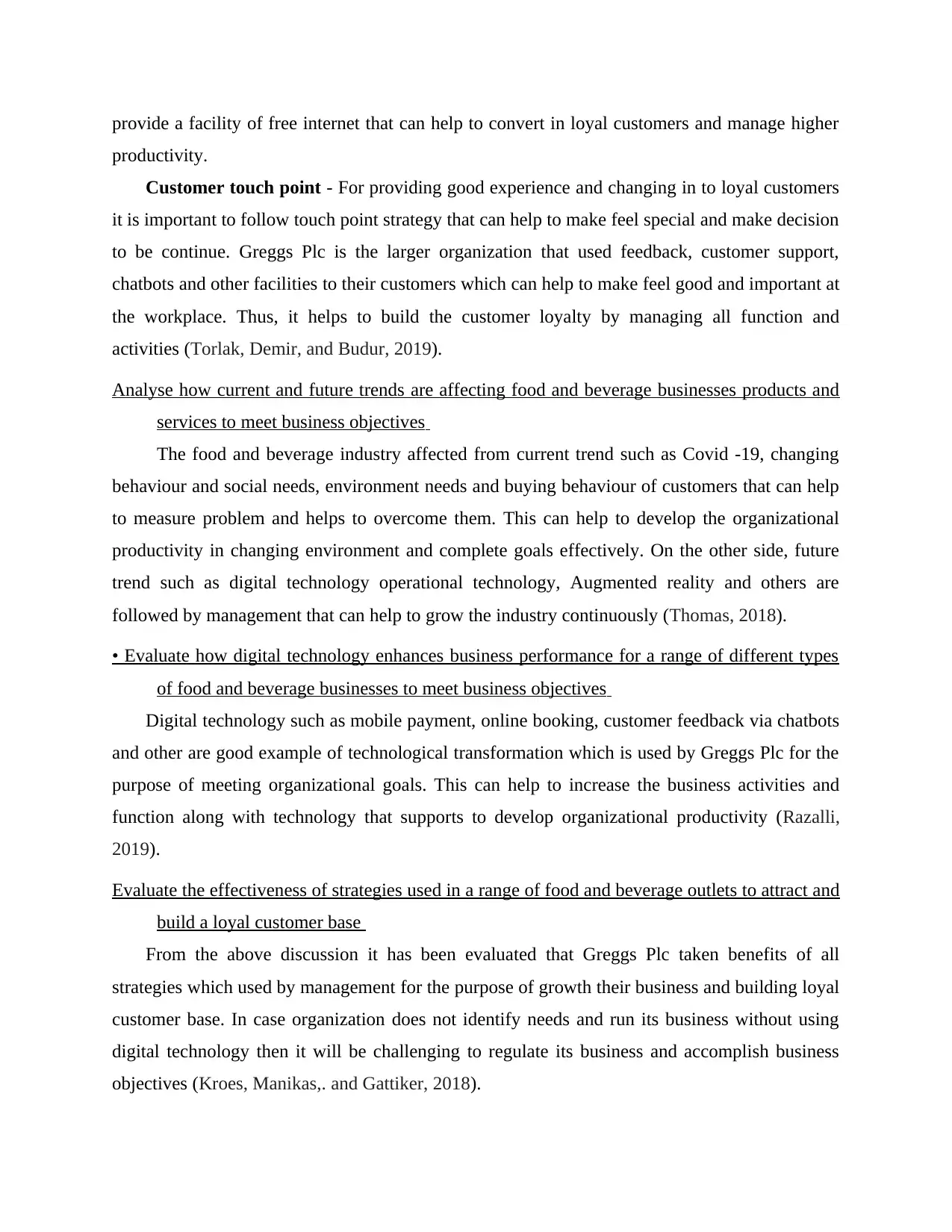
provide a facility of free internet that can help to convert in loyal customers and manage higher
productivity.
Customer touch point - For providing good experience and changing in to loyal customers
it is important to follow touch point strategy that can help to make feel special and make decision
to be continue. Greggs Plc is the larger organization that used feedback, customer support,
chatbots and other facilities to their customers which can help to make feel good and important at
the workplace. Thus, it helps to build the customer loyalty by managing all function and
activities (Torlak, Demir, and Budur, 2019).
Analyse how current and future trends are affecting food and beverage businesses products and
services to meet business objectives
The food and beverage industry affected from current trend such as Covid -19, changing
behaviour and social needs, environment needs and buying behaviour of customers that can help
to measure problem and helps to overcome them. This can help to develop the organizational
productivity in changing environment and complete goals effectively. On the other side, future
trend such as digital technology operational technology, Augmented reality and others are
followed by management that can help to grow the industry continuously (Thomas, 2018).
• Evaluate how digital technology enhances business performance for a range of different types
of food and beverage businesses to meet business objectives
Digital technology such as mobile payment, online booking, customer feedback via chatbots
and other are good example of technological transformation which is used by Greggs Plc for the
purpose of meeting organizational goals. This can help to increase the business activities and
function along with technology that supports to develop organizational productivity (Razalli,
2019).
Evaluate the effectiveness of strategies used in a range of food and beverage outlets to attract and
build a loyal customer base
From the above discussion it has been evaluated that Greggs Plc taken benefits of all
strategies which used by management for the purpose of growth their business and building loyal
customer base. In case organization does not identify needs and run its business without using
digital technology then it will be challenging to regulate its business and accomplish business
objectives (Kroes, Manikas,. and Gattiker, 2018).
productivity.
Customer touch point - For providing good experience and changing in to loyal customers
it is important to follow touch point strategy that can help to make feel special and make decision
to be continue. Greggs Plc is the larger organization that used feedback, customer support,
chatbots and other facilities to their customers which can help to make feel good and important at
the workplace. Thus, it helps to build the customer loyalty by managing all function and
activities (Torlak, Demir, and Budur, 2019).
Analyse how current and future trends are affecting food and beverage businesses products and
services to meet business objectives
The food and beverage industry affected from current trend such as Covid -19, changing
behaviour and social needs, environment needs and buying behaviour of customers that can help
to measure problem and helps to overcome them. This can help to develop the organizational
productivity in changing environment and complete goals effectively. On the other side, future
trend such as digital technology operational technology, Augmented reality and others are
followed by management that can help to grow the industry continuously (Thomas, 2018).
• Evaluate how digital technology enhances business performance for a range of different types
of food and beverage businesses to meet business objectives
Digital technology such as mobile payment, online booking, customer feedback via chatbots
and other are good example of technological transformation which is used by Greggs Plc for the
purpose of meeting organizational goals. This can help to increase the business activities and
function along with technology that supports to develop organizational productivity (Razalli,
2019).
Evaluate the effectiveness of strategies used in a range of food and beverage outlets to attract and
build a loyal customer base
From the above discussion it has been evaluated that Greggs Plc taken benefits of all
strategies which used by management for the purpose of growth their business and building loyal
customer base. In case organization does not identify needs and run its business without using
digital technology then it will be challenging to regulate its business and accomplish business
objectives (Kroes, Manikas,. and Gattiker, 2018).

CONCLUSION
From the above report, it is concluded that food and beverage industry is growing very
well throughout the world. The report includes different types of food and beverage business
such as fine dining business, self-service, traditional restaurants and many more. There are
different rating systems in the F&B industry that helps customers choose the right place to go
and enjoy services. These ratings also help to build a positive image of the company in the
market.
LO2
Covered in PPT
From the above report, it is concluded that food and beverage industry is growing very
well throughout the world. The report includes different types of food and beverage business
such as fine dining business, self-service, traditional restaurants and many more. There are
different rating systems in the F&B industry that helps customers choose the right place to go
and enjoy services. These ratings also help to build a positive image of the company in the
market.
LO2
Covered in PPT
Secure Best Marks with AI Grader
Need help grading? Try our AI Grader for instant feedback on your assignments.
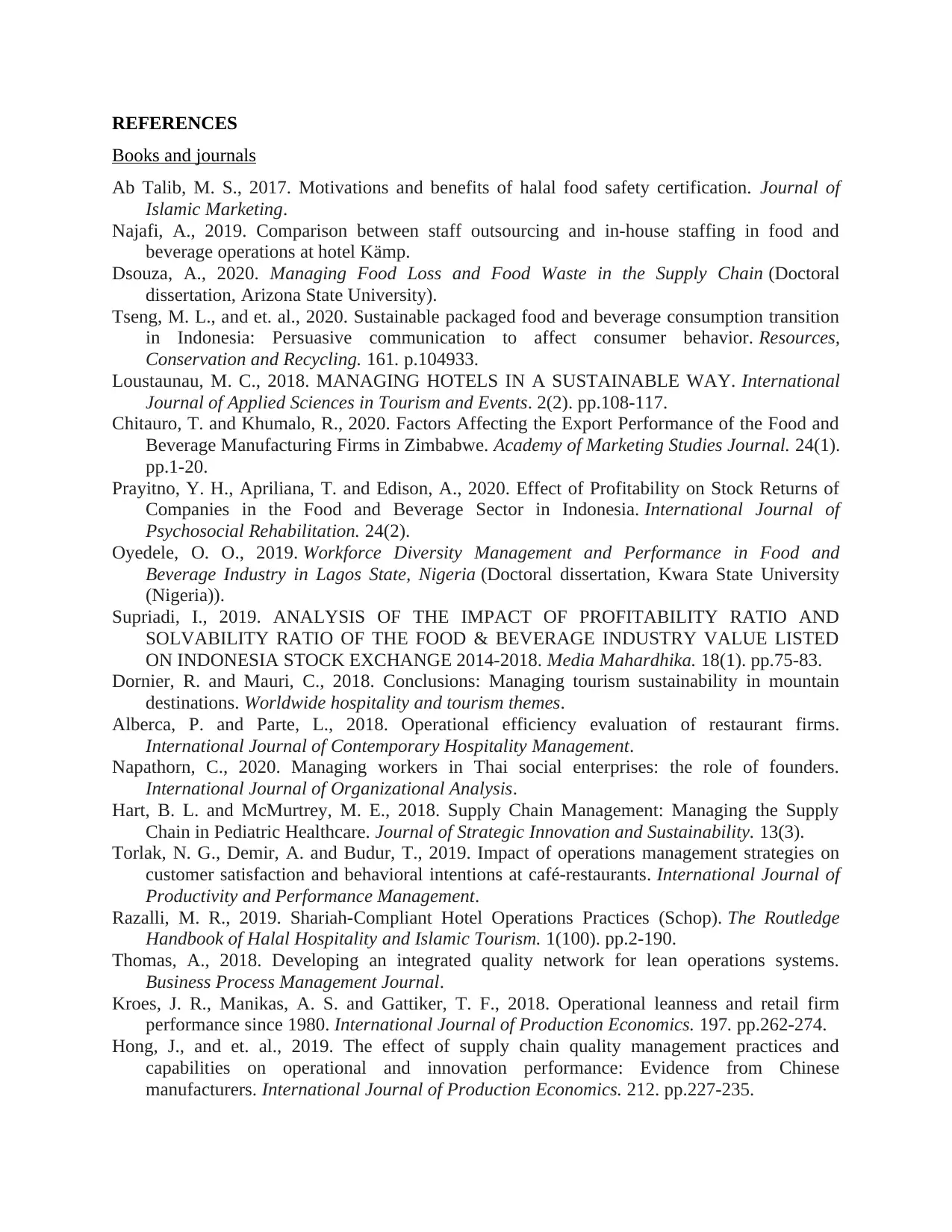
REFERENCES
Books and journals
Ab Talib, M. S., 2017. Motivations and benefits of halal food safety certification. Journal of
Islamic Marketing.
Najafi, A., 2019. Comparison between staff outsourcing and in-house staffing in food and
beverage operations at hotel Kämp.
Dsouza, A., 2020. Managing Food Loss and Food Waste in the Supply Chain (Doctoral
dissertation, Arizona State University).
Tseng, M. L., and et. al., 2020. Sustainable packaged food and beverage consumption transition
in Indonesia: Persuasive communication to affect consumer behavior. Resources,
Conservation and Recycling. 161. p.104933.
Loustaunau, M. C., 2018. MANAGING HOTELS IN A SUSTAINABLE WAY. International
Journal of Applied Sciences in Tourism and Events. 2(2). pp.108-117.
Chitauro, T. and Khumalo, R., 2020. Factors Affecting the Export Performance of the Food and
Beverage Manufacturing Firms in Zimbabwe. Academy of Marketing Studies Journal. 24(1).
pp.1-20.
Prayitno, Y. H., Apriliana, T. and Edison, A., 2020. Effect of Profitability on Stock Returns of
Companies in the Food and Beverage Sector in Indonesia. International Journal of
Psychosocial Rehabilitation. 24(2).
Oyedele, O. O., 2019. Workforce Diversity Management and Performance in Food and
Beverage Industry in Lagos State, Nigeria (Doctoral dissertation, Kwara State University
(Nigeria)).
Supriadi, I., 2019. ANALYSIS OF THE IMPACT OF PROFITABILITY RATIO AND
SOLVABILITY RATIO OF THE FOOD & BEVERAGE INDUSTRY VALUE LISTED
ON INDONESIA STOCK EXCHANGE 2014-2018. Media Mahardhika. 18(1). pp.75-83.
Dornier, R. and Mauri, C., 2018. Conclusions: Managing tourism sustainability in mountain
destinations. Worldwide hospitality and tourism themes.
Alberca, P. and Parte, L., 2018. Operational efficiency evaluation of restaurant firms.
International Journal of Contemporary Hospitality Management.
Napathorn, C., 2020. Managing workers in Thai social enterprises: the role of founders.
International Journal of Organizational Analysis.
Hart, B. L. and McMurtrey, M. E., 2018. Supply Chain Management: Managing the Supply
Chain in Pediatric Healthcare. Journal of Strategic Innovation and Sustainability. 13(3).
Torlak, N. G., Demir, A. and Budur, T., 2019. Impact of operations management strategies on
customer satisfaction and behavioral intentions at café-restaurants. International Journal of
Productivity and Performance Management.
Razalli, M. R., 2019. Shariah-Compliant Hotel Operations Practices (Schop). The Routledge
Handbook of Halal Hospitality and Islamic Tourism. 1(100). pp.2-190.
Thomas, A., 2018. Developing an integrated quality network for lean operations systems.
Business Process Management Journal.
Kroes, J. R., Manikas, A. S. and Gattiker, T. F., 2018. Operational leanness and retail firm
performance since 1980. International Journal of Production Economics. 197. pp.262-274.
Hong, J., and et. al., 2019. The effect of supply chain quality management practices and
capabilities on operational and innovation performance: Evidence from Chinese
manufacturers. International Journal of Production Economics. 212. pp.227-235.
Books and journals
Ab Talib, M. S., 2017. Motivations and benefits of halal food safety certification. Journal of
Islamic Marketing.
Najafi, A., 2019. Comparison between staff outsourcing and in-house staffing in food and
beverage operations at hotel Kämp.
Dsouza, A., 2020. Managing Food Loss and Food Waste in the Supply Chain (Doctoral
dissertation, Arizona State University).
Tseng, M. L., and et. al., 2020. Sustainable packaged food and beverage consumption transition
in Indonesia: Persuasive communication to affect consumer behavior. Resources,
Conservation and Recycling. 161. p.104933.
Loustaunau, M. C., 2018. MANAGING HOTELS IN A SUSTAINABLE WAY. International
Journal of Applied Sciences in Tourism and Events. 2(2). pp.108-117.
Chitauro, T. and Khumalo, R., 2020. Factors Affecting the Export Performance of the Food and
Beverage Manufacturing Firms in Zimbabwe. Academy of Marketing Studies Journal. 24(1).
pp.1-20.
Prayitno, Y. H., Apriliana, T. and Edison, A., 2020. Effect of Profitability on Stock Returns of
Companies in the Food and Beverage Sector in Indonesia. International Journal of
Psychosocial Rehabilitation. 24(2).
Oyedele, O. O., 2019. Workforce Diversity Management and Performance in Food and
Beverage Industry in Lagos State, Nigeria (Doctoral dissertation, Kwara State University
(Nigeria)).
Supriadi, I., 2019. ANALYSIS OF THE IMPACT OF PROFITABILITY RATIO AND
SOLVABILITY RATIO OF THE FOOD & BEVERAGE INDUSTRY VALUE LISTED
ON INDONESIA STOCK EXCHANGE 2014-2018. Media Mahardhika. 18(1). pp.75-83.
Dornier, R. and Mauri, C., 2018. Conclusions: Managing tourism sustainability in mountain
destinations. Worldwide hospitality and tourism themes.
Alberca, P. and Parte, L., 2018. Operational efficiency evaluation of restaurant firms.
International Journal of Contemporary Hospitality Management.
Napathorn, C., 2020. Managing workers in Thai social enterprises: the role of founders.
International Journal of Organizational Analysis.
Hart, B. L. and McMurtrey, M. E., 2018. Supply Chain Management: Managing the Supply
Chain in Pediatric Healthcare. Journal of Strategic Innovation and Sustainability. 13(3).
Torlak, N. G., Demir, A. and Budur, T., 2019. Impact of operations management strategies on
customer satisfaction and behavioral intentions at café-restaurants. International Journal of
Productivity and Performance Management.
Razalli, M. R., 2019. Shariah-Compliant Hotel Operations Practices (Schop). The Routledge
Handbook of Halal Hospitality and Islamic Tourism. 1(100). pp.2-190.
Thomas, A., 2018. Developing an integrated quality network for lean operations systems.
Business Process Management Journal.
Kroes, J. R., Manikas, A. S. and Gattiker, T. F., 2018. Operational leanness and retail firm
performance since 1980. International Journal of Production Economics. 197. pp.262-274.
Hong, J., and et. al., 2019. The effect of supply chain quality management practices and
capabilities on operational and innovation performance: Evidence from Chinese
manufacturers. International Journal of Production Economics. 212. pp.227-235.

Hua, N., and et. al., 2018. Do loyalty programs really matter for hotel operational and financial
performance?. International Journal of Contemporary Hospitality Management.
Ab Talib, M. S., 2017. Najafi, A., 2019 Dsouza, A., 2020 Tseng, M. L., and et. al., 2020
Loustaunau, M. C., 2018 Chitauro, T. and Khumalo, R., 2020 Prayitno, Y. H., Apriliana, T. and
Edison, A., 2020 Oyedele, O. O., 2019 Supriadi, I., 2019. Dornier, R. and Mauri, C., 2018
Alberca, P. and Parte, L., 2018 Napathorn, C., 2020 Hart, B. L. and McMurtrey, M. E., 2018.
Torlak, N. G., Demir, A. and Budur, T., 2019 Razalli, M. R., 2019 Thomas, A., 2018 Kroes, J.
R., Manikas, A. S. and Gattiker, T. F., 2018. Hong, J., and et. al., 2019
performance?. International Journal of Contemporary Hospitality Management.
Ab Talib, M. S., 2017. Najafi, A., 2019 Dsouza, A., 2020 Tseng, M. L., and et. al., 2020
Loustaunau, M. C., 2018 Chitauro, T. and Khumalo, R., 2020 Prayitno, Y. H., Apriliana, T. and
Edison, A., 2020 Oyedele, O. O., 2019 Supriadi, I., 2019. Dornier, R. and Mauri, C., 2018
Alberca, P. and Parte, L., 2018 Napathorn, C., 2020 Hart, B. L. and McMurtrey, M. E., 2018.
Torlak, N. G., Demir, A. and Budur, T., 2019 Razalli, M. R., 2019 Thomas, A., 2018 Kroes, J.
R., Manikas, A. S. and Gattiker, T. F., 2018. Hong, J., and et. al., 2019
1 out of 12
Related Documents
Your All-in-One AI-Powered Toolkit for Academic Success.
+13062052269
info@desklib.com
Available 24*7 on WhatsApp / Email
![[object Object]](/_next/static/media/star-bottom.7253800d.svg)
Unlock your academic potential
© 2024 | Zucol Services PVT LTD | All rights reserved.




